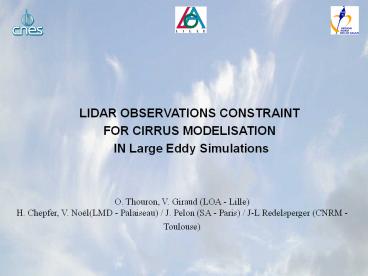R - PowerPoint PPT Presentation
1 / 18
Title:
R
Description:
LIDAR OBSERVATIONS CONSTRAINT FOR CIRRUS MODELISATION IN Large Eddy Simulations O. Thouron, V. Giraud (LOA - Lille) H. Chepfer, V. No l(LMD - Palaiseau) / J. Pelon ... – PowerPoint PPT presentation
Number of Views:69
Avg rating:3.0/5.0
Title: R
1
LIDAR OBSERVATIONS CONSTRAINT FOR CIRRUS
MODELISATION IN Large Eddy Simulations
- O. Thouron, V. Giraud (LOA - Lille)
- H. Chepfer, V. Noël(LMD - Palaiseau) / J. Pelon
(SA - Paris) / J-L Redelsperger (CNRM - Toulouse)
2
Introduction
- The reason that cirrus clouds are not well
understood is that many atmospheric processes
affect their development, structure and
evolution - on the locale scale radiation, aerosol
properties, gravity waves, shear instability,
latent heating, microphysical properties, . - On a larger scale interaction with jet
streams, interaction with planetary-scale waves,
passing pressure systems, large scale lifting or
descent ...
Successful parameterization of cirrus clouds
needs to be based on an understanding of all the
processes and their interactions.
3
Introduction
How active remote sensing bring the signatures of
processes and their interactions at local scales?
How active remote sensing may be convenient to
constrain physical parameterizations in Cloud
Resolving Models?
4
Plan
- strategy - model used to make LES simulations -
cirrus cloud generation - sensitivity study
microphysical processes - conclusion - perspective
5
Strategy
Observations
Active Observations Passive Observations
Idealized case Sensibility Study of the lidar
to the microphysical processes
Aircraft ECMWF radio sonde data
Comparison
Modelisation
Synthetic Observations
Radiatif transfer calculation
Microphysical Scheme MESO-NH
fields 2/3D
6
The model
Use the French atmospheric simulated system
meso-NH Run in 1, 2 or 3 dimensions Non
hydrostatic meso scale model Bulk microphysical
scheme Designed to study convective cloud or
precipitating cloud It was necessary - to adapt
the microphysical scheme to simulate cirrus -
to prognostic ice number concentration
to be abble to calculate synthetic
observations
7
Microphysical scheme
- - spherical particles
- - size distribution gamma modified
- First type SP
Water Vapor
SP
- - non spherical particles
- (columns or plates)
- - size distribution gamma modified
- Second type NSP
NSP
8
Resolution domain
Limit Conditions Cyclic
2D simulations
Sponge zone
50 m
100 m
9
Cirrus cloud generation
Cirrus clouds are generated in a similar way to
the GEWEX Cloud Systems Study (GCSS) cirrus cloud
intercomparison (Starr et al. 2000)
Cloud Forcing - cooling equivalent to ascent at
3 cm/s - between 7 and 10 km
Turbulent structure - initialized by artificial
heat perturbation (/- 0.01K) between 8 and 9 km
Duration 5 hours Radiation turned off
10
The sensitivity study
Base run Nu1000 l-3 Ri20mg.m-3
Adjustment on 100 Velocity Starr (1985)
nucleation
Meyer - Supersaturation ratio with respect to
ice - Ice nuclei number Nu
Transformation
Depend on the primary ice water content threshold
Deposition
Depend on the sursaturation in the cirrus
Sedimentation
Depend on velocity-mass relation parameters c and
d
11
Base run results after 4 hours Direct output
12
Base run results after 4 hours Deducted output
13
Sensitivity study Ice nuclei number
500 l-1 1000 l-1 1500 l-1
14
Sensitivity study the primary ice water content
threshold
Water Vapor
- 10 mg.m-3
- 20 mg.m-3 30mg.m-3
Nucleation
Deposition
SP
Sublimation
Sedimentation
Aggregation
Transformat
NSP
Sedimentation
15
Sensitivity study Fall speed velocity
Water Vapor
Nucleation
Deposition
SP
Sublimation
Sedimentation
Aggregation
Transformat
NSP
Sedimentation
16
Sensitivity study Deposition
Water Vapor
Nucleation
50 100 80
Deposition
SP
Sublimation
Sedimentation
Aggregation
Transformat
NSP
Sedimentation
17
Conclusion
Fall speed velocity
Transformation
Nucleation
Backscaterring Lidar
v
v
v
v
v
v
Depolarisation Lidar
v
v
Backscaterring Depolarisation
18
Perspectives
- Structure analysis FFT
- Radar data
- Used of real case in order to constrain the model































